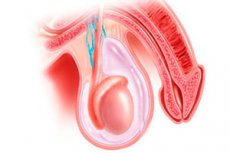Medical expert of the article
New publications
Testicular hydrocele surgery
Last reviewed: 04.07.2025

All iLive content is medically reviewed or fact checked to ensure as much factual accuracy as possible.
We have strict sourcing guidelines and only link to reputable media sites, academic research institutions and, whenever possible, medically peer reviewed studies. Note that the numbers in parentheses ([1], [2], etc.) are clickable links to these studies.
If you feel that any of our content is inaccurate, out-of-date, or otherwise questionable, please select it and press Ctrl + Enter.

Hydrocele (dropsy) of the testicle - the internal male genital organ - can be congenital, and in rare cases acquired. It is an accumulation of serous fluid between the membranes of the testicle, which leads to its enlargement. Detection of hydrocele in a newborn does not require a quick response, since it usually disappears by the end of the first year of life. Sometimes it has to be removed in both children and adults.
Hydrocele is the most common benign swelling of the scrotum, with an estimated incidence of 1% of the adult male population.[ 1 ] There is controversy regarding the treatment of primary hydrocele. Aspiration and sclerotherapy have been described; however, removal of the hydrocele, or hydrocelectomy, remains the treatment of choice for hydrocele.[ 2 ]
Indications for the procedure
When hydrocele occurs due to trauma to the perineum and scrotum, inflammatory disease of its organs, impaired lymphatic drainage, testicular torsion, conservative treatment is initially used to eliminate the cause. Fluid from the testicle is removed by puncture, and sclerosing drugs are injected inside. This often results in infection and complications.
Indications for surgical removal of hydrocele are the following symptoms:
- sharp pain in the scrotum;
- her redness;
- swelling of the genitals;
- pathological dysfunction of an organ.
Preparation
The operation is always preceded by a period of preparation, which consists of a comprehensive examination of the patient. The urologist conducts a primary tactile examination, gives a referral for an outpatient examination, which consists of a blood test, ultrasound of the inguinal canals and scrotal organs, [ 3 ] diaphanoscopy - transillumination of the testicles.
This is necessary to assess the scale of surgical intervention, to establish the volume of accumulated fluid. When pathologies that provoked dropsy are detected, therapeutic actions are primarily directed at them.
Technique to remove the testicular hydrocele
There are several techniques for performing operations to remove hydrocele in men, named after the surgeons who proposed them. There is no fundamental difference between them, but they differ in the plasticity of the testicular membrane.
Bergman's surgery involves removing some of it after releasing the hydrocele; Winkelmann's involves cutting, turning inside out and suturing behind the testicle. Lord proposed a less traumatic procedure called corrugation. [ 4 ]
Which method is rational to use depends on the size of the dropsy and its age.
Minimally accessible hydrocelectomy is performed by fenestration of the membrane [ 5 ] and traction technique to remove large hydrocele sacs through a small incision and with minimal dissection. The hydrocele sac is treated through a smaller scrotal skin incision along with excision of the smaller disc of the hydrocele sac. Minimally accessible hydrocelectomy provides better surgical outcome in terms of scrotal edema and induration, as well as patient satisfaction compared to traditional eversion-excisional hydrocelectomy.
An innovative and effective method of treating pathology is laser therapy. It ensures minimal tissue trauma, no blood loss, painlessness (performed under local anesthesia), speed of surgery, no scars, and a short rehabilitation period. [ 6 ]
Removal of hydrocele in a child
The procedure for removing hydrocele in a child is usually not performed before 1.5-2 years, since it can disappear on its own. The type of surgery is selected based on the characteristics of the disease. Thus, with communicating hydrocele (non-healed vaginal process of the peritoneum), the Ross method is used - the internal inguinal ring of the process is excised and ligated, a space is formed in the membranes of the testicle. [ 7 ]
This procedure involves a small incision in the groin area. Sometimes laparoscopy is used to perform it, but it has more postoperative complications, so it is not very popular.
Before this age, surgery is used if the hydrocele is combined with an inguinal hernia, increases and causes discomfort, and an infection joins in. After 10 years, the same methods are used as for adults. [ 8 ]
Consequences after the procedure
After the removal of the hydrocele, unpleasant pain sensations at the incision site may be observed for quite a long time, up to a year. There may be postoperative discomfort, temporary limitation of normal activity and complications. This is due to the pinching of tissues or nerve endings in the scar. [ 9 ]
Complications after the procedure
According to statistics, complications after the procedure occur in 2-8% of cases: hematoma, infection, persistent swelling, chronic pain and decreased fertility. There are relapses, there is a small risk of infertility (5%). The most dangerous is a violation of blood circulation in the testicle, which can lead to its atrophy. [ 10 ]
Care after the procedure
On the first day after surgery, the patient is given a painkiller; on the next few days, a laxative may be needed to avoid straining during bowel movements.
After hydrocele removal, the testicles should not be squeezed, and tight underwear should not be worn. Adults are not recommended to engage in heavy physical labor or sex for 2 weeks, and children are given a month off from physical education.
Reviews
Parents of boys who have encountered this problem, and adult men understand that an operation to remove dropsy is the only way to get rid of it, to find a normal life, including a full sexual life, and to have children.
The reviews emphasize that people carefully choose medical institutions for the procedure and well-established specialists, fortunately there is the Internet, where you can read different opinions.

